When it comes to building muscle and gaining weight, intense workouts are only part of the equation. Nutrition is key to optimizing muscle growth, and protein — often referred to as the building block of muscle — is essential to this process. (1) The final, and most important aspect, is overall energy intake. (2) Without an excess of calories, you can’t make the most of your training or protein intake. The best protein shakes can be an easy, delicious way to meet your calorie and protein goals.
While there are plenty of weight gainer shakes on the market, they’re usually just blends of protein powder and maltodextrin, a simple carbohydrate. They don’t offer much when it comes to vitamins, minerals, or variety. If you’re looking for a more nutritious, budget-friendly option, you can easily create delicious, energy-dense protein shakes with whole foods and protein powders that fit a variety of different dietary patterns. Here are the best protein shake recipes for weight gain out there.
The 5 Best Protein Shake Recipes for Weight Gain
Many of us have suffered through at least one grainy, lukewarm blend of bland protein powder in water. Fortunately, there are ways to make your protein shake more enjoyable and satisfying. You’ll boost your calorie intake, give yourself the nutrition you need to increase muscle mass, and have a fantastic taste experience with these weight gain smoothie recipes — all without the added sugars. Healthy weight gain, here we come.
- Chocolate Peanut Butter Banana Milkshake
- Vegan Tropical Paradise Shake
- Greek Yogurt Parfait Shake
- Vanilla Cinnamon Oat Shake
- Vegan Banana Cashew Cream Shake
1. Chocolate Peanut Butter Banana Milkshake
If you’re a fan of peanut butter cups, you’re sure to like this recipe. This shake provides about 500 calories and roughly 25 grams of high-quality protein from low-lactose options like the best whey isolates to stimulate muscle protein synthesis.(3)
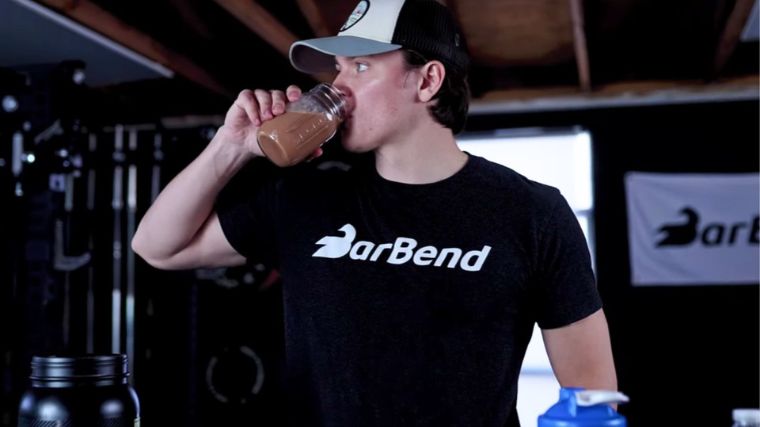
Compared to regular whey protein, isolate is generally more tolerable to folks with lactose intolerance. Plus, with a creamy, milkshake-like texture from the frozen banana, you might want to have it for dessert!
Nutrients
- Calories: 500
- Protein: 35 grams
- Carbs: 50 grams
- Fats: 18 grams
- Notable Micronutrients: Whole milk is high in calcium and bananas are a good source of potassium.
Ingredients
- 1 scoop chocolate whey protein isolate
- 1 cup lactose-free whole milk
- 1 tablespoon peanut or almond butter
- 1 tablespoon honey
- 1 frozen banana
Instructions
Start by pouring the milk into your blender, then add the honey. Add the frozen banana in small chunks. Add remaining ingredients. Blend ingredients together until smooth.
2. Vegan Tropical Paradise Shake
Vegan diets can be just as effective as omnivorous diets for supporting muscle growth and weight gain. (4) As registered dietitian Austin Bou points out, “It was once believed that plant-based diets are inadequate for muscle growth. In fact, recent research has shown that vegan diets can produce equal results when compared to an omnivorous diet; however, it’s important to focus on the amount of protein consumed.” This is definitely a shake that can help you hit that mark.
Whether you’re vegan or simply wanting to include more high-protein vegetables and fruits in your diet, this fruity, refreshing shake provides about 450 calories and 30 grams of protein from pea protein powder and almond butter.
Nutrients
- Calories: 450
- Protein: 30 grams
- Carbs: 45 grams
- Fats: 16 grams
- Notable Micronutrients: Mango and pineapple are excellent sources of vitamin C, and the fruits, oats, and nut butter all provide a boost of dietary fiber.
Ingredients
- 1 scoop vanilla pea protein powder
- 1 cup oat milk
- 1 tablespoon peanut or almond butter
- ½ cup frozen mango chunks
- ½ cup frozen pineapple chunks
Instructions
Start by pouring the oat milk into your blender. Add the frozen fruit chunks. Add remaining ingredients. Blend ingredients together until smooth.
3. Greek Yogurt Parfait Shake
If you like to snack on Greek yogurt with berries or granola, you’re in luck. You can make it even more delicious and portable by turning it into a protein shake! This recipe provides about 30 grams of protein from casein and Greek yogurt, which can help stimulate muscle protein synthesis with their high leucine content (characteristic of animal-based protein sources.) (3)
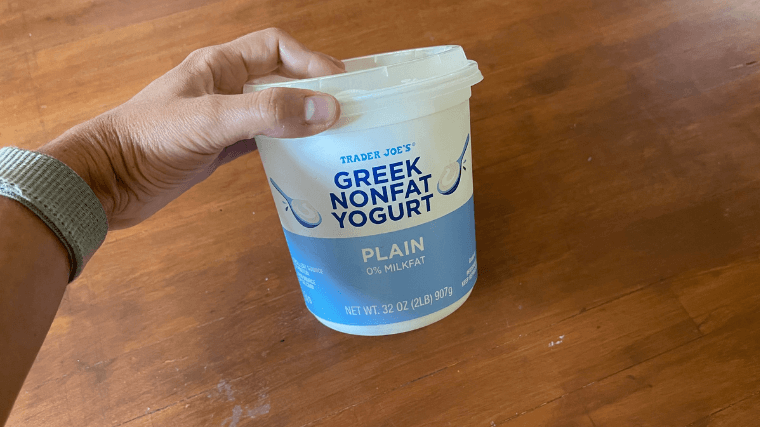
It’s also sweetened with honey, which is an energy-dense carb source that contributes to its high calorie content — about 500 calories.
Nutrients
- Calories: 500
- Protein: 35 grams
- Carbs: 45 grams
- Fats: 17 grams
- Notable Micronutrients: Mixed berries are high in vitamin C and Greek yogurt is a good source of calcium.
Ingredients
- 1 scoop vanilla casein protein powder
- 1 cup unsweetened almond milk
- 1 tablespoon peanut or almond butter
- ½ cup frozen blueberries, strawberries, or mixed berries
- ½ cup plain Greek yogurt
- 1 tablespoon honey
Instructions
Start by pouring the almond milk into your blender, then add the honey. Add the frozen fruit and Greek yogurt. Add remaining ingredients. Blend ingredients together until smooth.
4. Vanilla Cinnamon Oat Shake
Love your morning oatmeal, and want to take it on the go? You can add it to your next protein shake. This blend of egg white protein, oats, fruit, and maple syrup might sound like breakfast in a blender, but trust me, this type of protein powder doesn’t taste like scrambled eggs!

Think: overnight oats, but smooth. The combination of energy-dense ingredients and high-quality protein powder will add about 35 grams of protein and nearly 600 calories. (Egg white powder not your vibe? You can swap in any of the best tasting protein powders!)
Nutrients
- Calories: 600
- Protein: 35 grams
- Carbs: 60 grams
- Fats: 23 grams
- Notable Micronutrients: Oats and apples are both good sources of fiber.
Ingredients
- 1 scoop vanilla egg white protein powder
- 1 cup oat milk
- ½ cup dry instant or old-fashioned rolled oats, blended into a powder
- ½ a medium apple, peeled and chopped
- 1 tablespoon maple syrup
- 1 tablespoon walnut butter
- 1 teaspoon cinnamon
Instructions
Start by pouring the oat milk into your blender, then add the maple syrup. Add the protein powder and oats. Add remaining ingredients. Blend ingredients together until smooth.
5. Vegan Banana Cashew Cream Shake
Soy protein is another great plant-based alternative to dairy-based protein powders, and it’s the base for this delicious recipe. (3) The blend of creamy cashew milk, cashew butter, and frozen banana make it seem like more of a milkshake than a protein shake. It’s an easy way to add another 30 grams of protein and roughly 400 calories to your daily intake.
Nutrients
- Calories: 400
- Protein: 30 grams
- Carbs: 35 grams
- Fats: 20 grams
- Notable Micronutrients: Cashew butter is high in magnesium, and fortified cashew milks can also provide calcium and vitamin D.
Ingredients
- 1 scoop vanilla soy protein powder (or other one of the other best vegan protein powders of your choice)
- 1 cup unsweetened cashew milk
- 1 frozen banana
- 1 tablespoon cashew butter
Instructions
Start by pouring the cashew milk into your blender. Add the frozen banana in small chunks. Add remaining ingredients. Blend ingredients together until smooth.
Best Protein Shake for Weight Gain Ingredients
Now that you’ve tried some game-changing protein shake recipes, you might want to build your own. Here are the key ingredients to get you started!
Ingredient 1 — Protein Powder
The best protein powders can be equally beneficial when combined with adequate energy intake and training, so choose the one that will best suit your dietary pattern and digestion.(3)(4)(5) (The exception: collagen protein and collagen peptides don’t contain the proper combination of amino acids to support muscle protein synthesis, so this wouldn’t be a useful ingredient for muscle growth alone.) (6)(7)
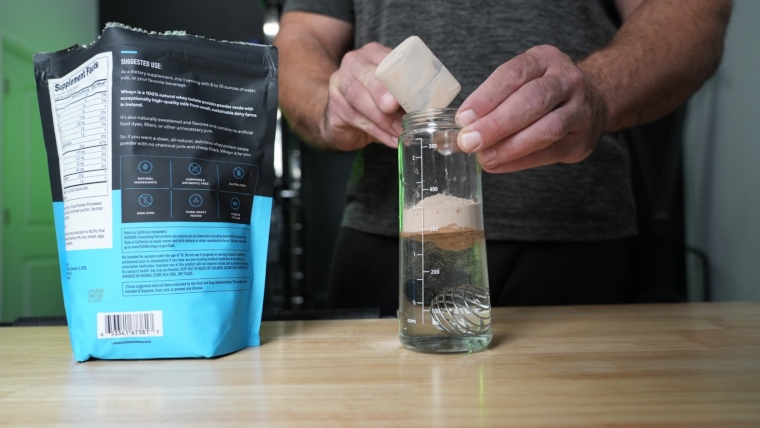
Animal-based protein powders like whey protein, casein, and egg white are all high-quality protein sources due to their blend of amino acids and high leucine content. Plant-based protein powders like soy or pea protein are generally formulated to provide the right amount of amino acids to support muscle growth. (3)(4)(5)
Ingredient 2 — Milk or Milk Alternative
While you can make a protein shake with water, you can add more calories — plus deliciousness and texture — to your protein shake by using milk or a milk alternative. Whole milk is more energy-dense than reduced fat versions due to its higher fat content, while oat, hemp, and soy milk tend to be the more caloric plant-based milk alternatives.(8)
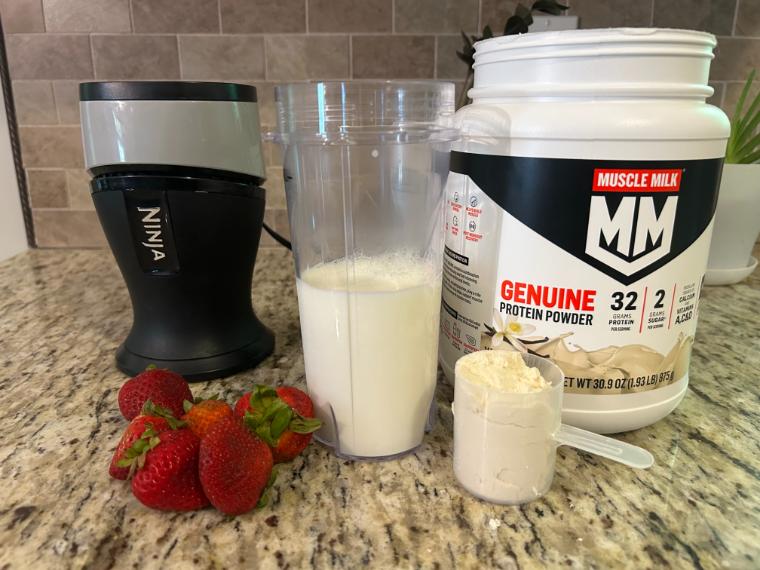
These milks can also add a different texture to your shake, which could make it more appetizing in some cases but too filling in others. If you’re adding a thick ingredient like yogurt or oatmeal, you might want to use a milk alternative with a higher water content, like almond milk, so your shake isn’t so thick that you feel full halfway through.
[Related: Best Whey Protein Powders]
Ingredient 3 — Nut Butter
Nut butter is high in fat, making it extremely energy-dense. This ingredient adds a significant number of calories without adding too much volume to your protein shake. Nut butters tend to have very similar nutrient profiles, but their tastes vary. Cashew butter tends to be sweeter, while almond butter has a milder, earthy taste.
Whatever type you choose, be sure to pick a brand that’s free from hydrogenated oils. These are used to maintain the texture and shelf life of many nut butters, but they contain trans fats which are linked to heart disease and should be avoided. (9)
Ingredient 4 — Frozen Fruit
Protein powder, milk, and nut butter can make a great shake on their own, but frozen fruit takes your shake to another level. Fruit makes your shake sweeter and more nutritious by adding fiber and micronutrients, like vitamin C and potassium. Frozen fruit – especially bananas – turn your protein shake into a protein smoothie. Bananas are one of the most energy-dense options, but plenty of other fruits like berries, pineapple, mango, and peaches also freeze well.

[Related: Best Protein Bars]
Optional Additions
If you want to make your shake or smoothie even more energy dense, you can sweeten your shake with honey or maple syrup, sprinkle in some chia seeds, or even add blended oats. These can all add more calories to your shake without increasing the amount you have to drink.
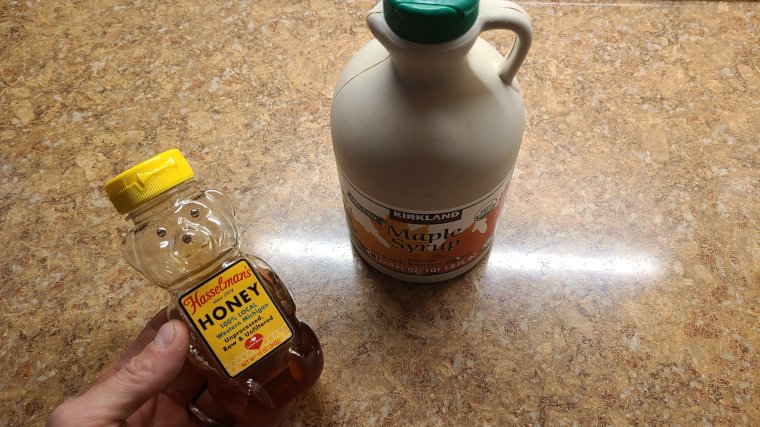
Honey and maple syrup are energy dense, packing plenty of carbohydrates in small amounts. Like nut butters, chia seeds add healthy fats and extra calories to your shake without taking up much extra space. Oats will add more carbohydrates and make your shake thicker, so they might pair better with a thinner milk base, like almond milk.
If you’ve tried all of the above and you still aren’t seeing the gains you’d expect, you could swap your protein powder base for a weight gain shake to add even more calories to the mix.
Tips From a Health Coach on How to Make Protein Shake Recipes for Weight Gain
Of course, this isn’t an exhaustive list of ingredients or combinations. If you’re a protein shake pro and you’re ready to get creative, follow these general guidelines.
Choose High-Calorie Ingredients
Protein powders are, obviously, high in protein; they’re also relatively low in calories because they contain hardly any fat or carbohydrates. So, if you want to make your protein shake more effective for weight gain, you need to add other sources of calories from energy-dense foods.
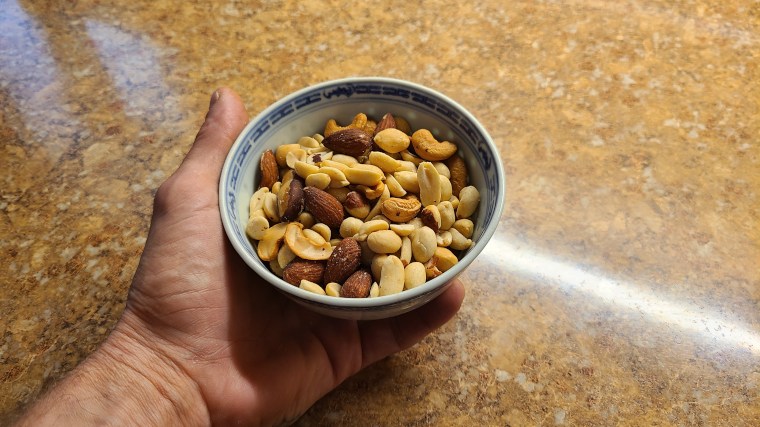
Energy-dense foods are high in calories per gram; in other words, they pack plenty of calories into a small serving. Some examples include oils, nuts, and nut butters, which are all naturally high in healthy fats. Other foods, like dried fruit, can be made more energy-dense through processing. The carbohydrates become more concentrated once the water is removed. Milk and yogurt are sold with different fat content, like 1% or whole milk.
When you’re putting your grocery list together, opt for the ingredients with more calories per serving, like whole milk instead of fat-free milk and real peanut butter instead of low-calorie powdered versions.
How much protein do you need? Let our BarBend protein intake calculator help you figure it out.
Protein Intake Calculator
Make Sure It Tastes Good
Eating enough for weight gain can be challenging, especially if you’re starting to get tired of your meal prep. This is why it’s important to swap boring, plain protein shakes for tasty, creative recipes like these.
Have you noticed how easy it is to eat more than usual when you’re at a buffet? It’s not just you; this phenomenon is sometimes called the buffet effect, and it occurs when there’s a high variety of tasty, novel food around. (10) Use it to your advantage! The more you enjoy your food and the more variety you have, the easier it is to hit your calorie and protein goals.
[Related: Protein Intake Calculator]
Make Sure It Digests Well
If there’s one thing that can sideline your nutrition goals for the day, it’s uncomfortable digestion. You might already be feeling a little too full most of the time, so if you want to keep meeting your goals, you need to make sure your protein shake will leave you feeling comfortably satisfied.
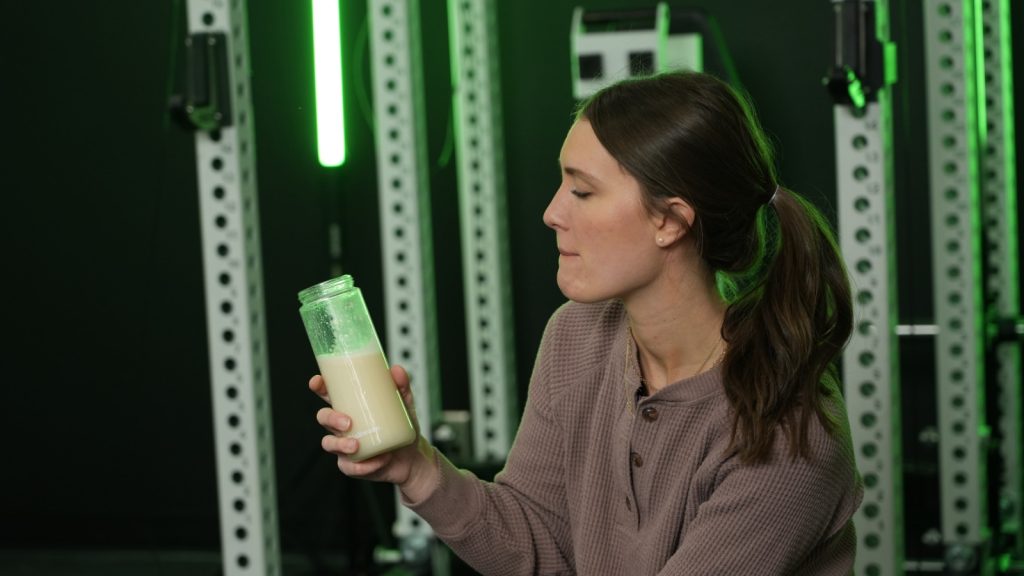
Lactose is one of the most common offenders when it comes to gastrointestinal distress like gas and bloating. An estimated 68% of the global population are lactose intolerant, or unable to digest lactose, a sugar found in many milk-based products — including whey protein concentrate. (11) Stick with lactose-free milk and whey isolate or a non-dairy protein powder if you struggle with lactose.
Some protein shakes contain other ingredients to boost their carbohydrate and fiber content. Inulin is a type of functional fiber added to many “health foods,” like meal replacement-style protein shakes. Despite its potential health benefits, it’s known to cause severe gas and bloating in some people. (12) While it’s rare to find this ingredient in most protein powders, it’s worth checking if you’re purchasing one that contains carbohydrate sources as well.
[Related: How to Bulk]
Best Protein Shake Recipes for Weight Gain FAQs
What do you put in a protein shake for weight gain?
The basic foundation for a weight gain protein shake would be a protein powder, a high-calorie milk or milk alternative, and some type of nut butter. From there, you can add fruit, blended oats, or liquid sweeteners like honey.
Can I drink two protein shakes a day to gain weight?
Protein shakes like these can be an easy way to pack a lot of calories into a small package that digests quickly and doesn’t leave you feeling too full. Adding two shakes to your current dietary pattern could shift you into a caloric surplus. If you only drink two of these shakes per day, though, you would very likely be undereating and could put your health at risk.
Can a skinny person gain weight with protein shakes?
While people respond differently to changes in their energy balance, and some might have a harder time gaining weight, it’s still achievable with an energy surplus. If protein shakes like these add enough extra calories to your daily intake, you’ll likely gain weight.
References
- Wirth, J., Hillesheim, E., & Brennan, L. (2020). The Role of Protein Intake and its Timing on Body Composition and Muscle Function in Healthy Adults: A Systematic Review and Meta-Analysis of Randomized Controlled Trials. The Journal of nutrition, 150(6), 1443–1460. https://doi.org/10.1093/jn/nxaa049
- Oxfeldt, M., Phillips, S. M., Andersen, O. E., Johansen, F. T., Bangshaab, M., Risikesan, J., McKendry, J., Melin, A. K., & Hansen, M. (2023). Low energy availability reduces myofibrillar and sarcoplasmic muscle protein synthesis in trained females. The Journal of physiology, 601(16), 3481–3497. https://doi.org/10.1113/JP284967
- Lynch, H. M., Buman, M. P., Dickinson, J. M., Ransdell, L. B., Johnston, C. S., & Wharton, C. M. (2020). No Significant Differences in Muscle Growth and Strength Development When Consuming Soy and Whey Protein Supplements Matched for Leucine Following a 12 Week Resistance Training Program in Men and Women: A Randomized Trial. International journal of environmental research and public health, 17(11), 3871. https://doi.org/10.3390/ijerph17113871
- Monteyne, A. J., Coelho, M. O. C., Murton, A. J., Abdelrahman, D. R., Blackwell, J. R., Koscien, C. P., Knapp, K. M., Fulford, J., Finnigan, T. J. A., Dirks, M. L., Stephens, F. B., & Wall, B. T. (2023). Vegan and Omnivorous High Protein Diets Support Comparable Daily Myofibrillar Protein Synthesis Rates and Skeletal Muscle Hypertrophy in Young Adults. The Journal of nutrition, 153(6), 1680–1695. https://doi.org/10.1016/j.tjnut.2023.02.023
- Pinckaers, P. J. M., Kouw, I. W. K., Gorissen, S. H. M., Houben, L. H. P., Senden, J. M., Wodzig, W. K. H. W., de Groot, L. C. P. G. M., Verdijk, L. B., Snijders, T., & van Loon, L. J. C. (2023). The Muscle Protein Synthetic Response to the Ingestion of a Plant-Derived Protein Blend Does Not Differ from an Equivalent Amount of Milk Protein in Healthy Young Males. The Journal of nutrition, 152(12), 2734–2743. https://doi.org/10.1093/jn/nxac222
- Oikawa, S. Y., Kamal, M. J., Webb, E. K., McGlory, C., Baker, S. K., & Phillips, S. M. (2020). Whey protein but not collagen peptides stimulate acute and longer-term muscle protein synthesis with and without resistance exercise in healthy older women: a randomized controlled trial. The American journal of clinical nutrition, 111(3), 708–718. https://doi.org/10.1093/ajcn/nqz332
- Robberechts, R., Poffé, C., Ampe, N., Bogaerts, S., & Hespel, P. (2023). Partly Substituting Whey for Collagen Peptide Supplementation Improves Neither Indices of Muscle Damage Nor Recovery of Functional Capacity During Eccentric Exercise Training in Fit Males. International journal of sport nutrition and exercise metabolism, 34(2), 69–78. https://doi.org/10.1123/ijsnem.2023-0070
- Walther, B., Guggisberg, D., Badertscher, R., Egger, L., Portmann, R., Dubois, S., Haldimann, M., Kopf-Bolanz, K., Rhyn, P., Zoller, O., Veraguth, R., & Rezzi, S. (2022). Comparison of nutritional composition between plant-based drinks and cow’s milk. Frontiers in nutrition, 9, 988707. https://doi.org/10.3389/fnut.2022.988707
- Michels, N., Specht, I. O., Heitmann, B. L., Chajès, V., & Huybrechts, I. (2021). Dietary trans-fatty acid intake in relation to cancer risk: a systematic review and meta-analysis. Nutrition reviews, 79(7), 758–776. https://doi.org/10.1093/nutrit/nuaa061
- Cunningham, P. M., Roe, L. S., Keller, K. L., & Rolls, B. J. (2023). Variety and portion size combine to increase food intake at single-course and multi-course meals. Appetite, 191, 107089. https://doi.org/10.1016/j.appet.2023.107089
- Storhaug, C. L., Fosse, S. K., & Fadnes, L. T. (2017). Country, regional, and global estimates for lactose malabsorption in adults: a systematic review and meta-analysis. The lancet. Gastroenterology & hepatology, 2(10), 738–746. https://doi.org/10.1016/S2468-1253(17)30154-1
- Major, G., Pritchard, S., Murray, K., Alappadan, J. P., Hoad, C. L., Marciani, L., Gowland, P., & Spiller, R. (2017). Colon Hypersensitivity to Distension, Rather Than Excessive Gas Production, Produces Carbohydrate-Related Symptoms in Individuals With Irritable Bowel Syndrome. Gastroenterology, 152(1), 124–133.e2. https://doi.org/10.1053/j.gastro.2016.09.062